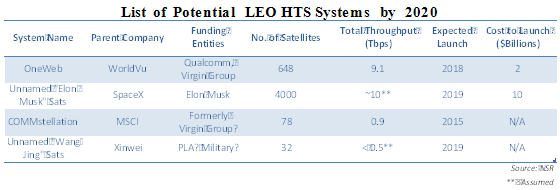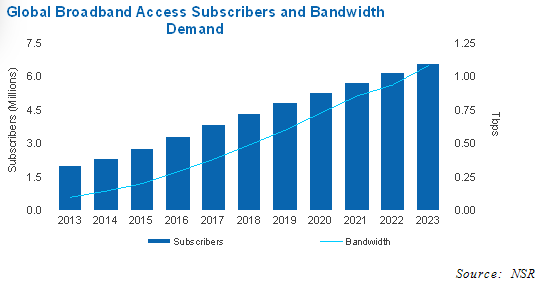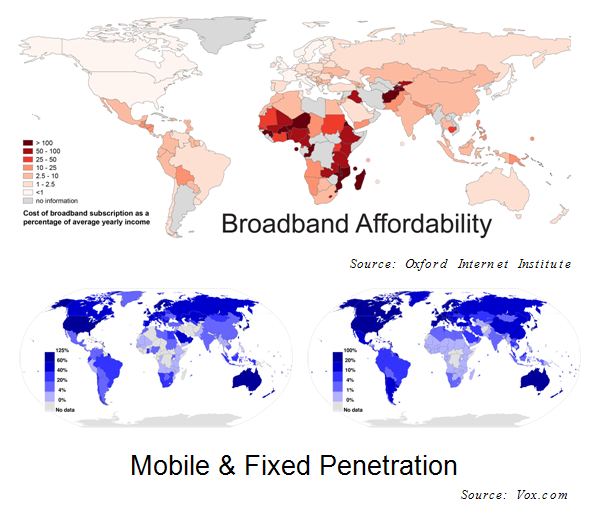GEO-HTS Here Today…but is LEO-HTS the Future?
Jan 19th, 2015 by
Prashant Butani, NSR
New Pockets of Cash
LEO satellites have seen at least
four separate ventures announced, and surely
many more filings made, over the past two years. In an
industry that is always at the “cusp” of something and
perpetually ripe for a “paradigm shift” NSR has adopted
a cautiously optimistic stand to LEO constellations.
This time around, the entry of Elon Musk and
Richard Branson as heavyweights contending each
other for a piece of the global broadband pie, has
prompted a new wave of interest and deep pockets of
cash.

Satellite Broadband Numbers Today
However, it is important to look
at consumer broadband economics, no matter how
well funded the kitty. If even half of the LEO
constellations in the exhibit above see the light of
day, we are looking at a subscriber and bandwidth
landscape that is totally different from any projection
that would be considered achievable in today’s date.
NSR’s
VSAT and Broadband Satellite Markets,
13th Edition report estimates
consumer broadband subscribers over satellite reaching
levels of 6.5 Million by 2023, and
bandwidth demand about 1.2 Tbps by the
same timeframe. These figures are made up almost
entirely of GEO HTS systems that have
built subscriber numbers over two or more
generations of satellites. NSR also projects
that the total supply of GEO HTS systems will cross 2
Tbps by 2023. The LEO HTS systems listed above are
together adding up to more than 20 Tbps
of supply! The deviation from what constitutes today’s
satellite broadband subscribers, including HughesNet,
ViaSat Exede, Eutelsat Tooway, SES SBBS, YahClick,
Avanti and others is clearly that of an order of
magnitude! So from purely economic terms, what
needs to change?

A Wish List
Two items are aimed at making
satellite broadband more affordable, something
that almost all LEO constellations want to achieve:
- Cost of CPE today
is around $250-$500. Is an order of magnitude
reduction expected here to $25-$50? Even a
terrestrial broadband connection needs $20 CPE in
most parts of the world, so perhaps a 50% reduction
at best is realistic?
- ARPUs today are in
the range of $50-$200. Another 10-fold reduction
expected here to $5-$20? Residential broadband in
most parts starts at about $10 per month for a 2Mbps
connection so this again seems to be an
over-reaching expectation.
Affordability and Alternatives
The first map exhibit below shows
broadband affordability as a percentage of income with
the darker countries having poorer connectivity.
Clearly, the ones that can afford broadband
already have it. They want more, yes, to watch
Netflix primarily but is LEO HTS the answer to a
soon-to-be slow 100Mb Fiber-to-the-Home? The two maps in
shades of blue show fixed and mobile broadband
penetration. Somewhat less clear are the African and
Asian countries where affordability may be low
but mobile broadband has done well in terms of
connecting people. Will this cellular industry be
disrupted by LEO-HTS alone, especially when its revenues
are larger than satellite by an order of magnitude?

Oh, By the Way…
Both SpaceX and Virgin have
launcher offerings of their own, which would
make it somewhat natural for the companies to see the
launch of hundreds, if not thousands, of satellites as a
nice way to flex some serious “space” muscle. There are
also plans to colonize Mars and send tourists to space,
but let’s not go there for now. Committing to providing
ubiquitous broadband coverage to billions is
altruistic on one hand and a “me too” stab at
Google and Facebook on the other. A happy
side-effect would be a share of the 30-odd
annual commercial satellite launches in GEO falling into
either basket in the longer term, even as both launch
systems are some way away from being truly flight
proven. It helps that the likes of Arianespace are
operating at a packed manifest and
smaller systems like Sea Launch are falling by the
wayside.
Bottom Line
If Elon or Richard or Google or Facebook
want to connect the “next billion” people to a satellite
based Internet solution, a lot has to change besides
just cost of hardware and service. Other constellations
that started with a similar vision soon ran into either
costly antenna design, or the need to
pivot to an enterprise market that made
more sense in the longer term, or both. The recent
shake-ups at the likes of Kymeta are not helping the
larger ecosystem, and neither are the hurdles in terms
of gateways required or landing rights
in various countries. Global ISPs, while growing into
behemoths of the likes of Comcast, AT&T, Verizon,
Vodafone and others are struggling to expand their
network infrastructure without adopting priority data
pricing strategies that are the subject of Net
Neutrality debates worldwide. Funding seems to be the
least of the concerns for the satellite broadband
entrepreneurs right now, and rightly so.

